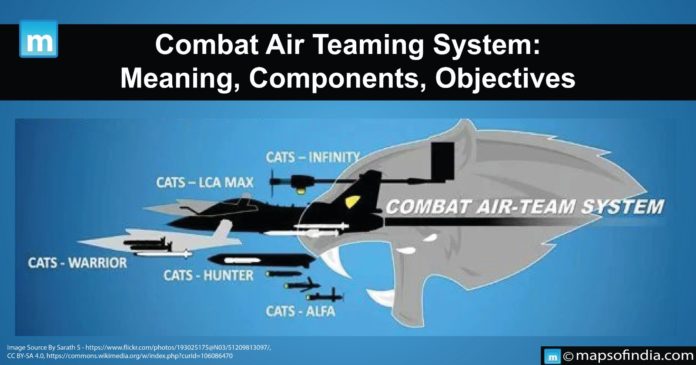Hindustan Aeronautics Limited (HAL) launched a Combat Air Teaming System (CATS). It is made in India and is an operated unmanned combat air teaming system. The twin-seated HAL Tejas is the mothership aircraft. Many other governments, as well as private agencies, have contributed to it, such as National Aerospace Laboratories (NAL), Defence Research and Development Organisation (DRDO) and a private company, Newspace Research and Technologies (NRT).
This system will consist of a manned fighter aircraft acting as a “Mothership” of the system and a set of swarming UAVs and UCAVs governed by the mothership aircraft. Hindustan Aeronautics Limited (HAL) will likely complete all the project-related developmental work by 2024 or maximum, 2025.
What is the Combat Air Teaming System?
The Combat Air Teaming System (CATS) is an automated-operated unmanned drone in the design phase. Hindustan Aeronautics Limited invested Rs 400 million. The Combat Air Teaming System will be valid for the Indian Navy and Indian Force.
It is a combination of manned and unmanned phenomena. CATS-MAX, a manned mothership, is the heart of the system.
The Background of the Combat Air Teaming System
In 2019, Hindustan Aeronautics Limited presented the current concept and design. This concept also includes the family of artificial intelligence (AI), which connects subsystems. These subsystems will later control and perform some autonomous missions.
In the upcoming years, the combat air teaming system will also include unmanned cargo transport and a rotary unmanned aerial vehicle (RUAV) that will carry a payload of 25–30 kg. This cargo and rotary transport will drop around 18,000 feet above sea level.
Components of CATS
- CATS Warrior
- CATS Hunter
- CATS ALFA
- CATS Infinity
1. CATS-Warrior
The striking power of CATS comes from several unmanned combat aeronautical vehicles known as CATS-Warrior. It can quickly reach a height of 36-40,000 feet. The total radius of the operation can be 300 km with an endurance of nearly 2 hours.
There will be two PTAE-W engines, which will cost Rs 40 crore each. The CATS-Warrior can strike ground targets up to 300 km inside the enemy’s territory. The unmanned warriors could also be sent on a suicide mission, 900–1000 km inside the enemy’s territory.
2. CATS-Hunter
CATS-Hunters are missiles that are powered by a turbojet. The missile’s maximum range is about 300 km, which is carried on the mothership’s wings. The hunters can be released once the mothership reaches its launching point.
These hunters can fly at about 200-300 km height and execute their mission with 250 kg warheads.
3. CATS-Alfa
CATS-Alfa, which stands for Combat Air Teaming System-Air Launched Flexible Assets, Is a low-cost asset with minimal ammunition. They are small drones that warriors carry in multiple numbers in a canister termed a “glide pod”.
While staying in their territory, the mothership can launch the ALFAs about 200 km from their target into the enemy’s territory. After gliding for about 100 km, the glide pod launches the ALFAs, which assume a formation for the attack. The ALFA has the capability to travel another 100 km to strike the designated surface target.
4. CATS-Infinity
CATS-Infinity is a high-altitude pseudo-satellite that can be launched as a control vehicle and stay aloft for up to 6 months. It is unique from other combat air teaming systems as they are powered by solar energy. It has enormous wings that accommodate solar panels.
It will work as a communication bridge between UAVs and satellites by providing a video feed from the battlefield.
Objectives of CATS
1. Atmospheric Satellites
The Combat Air Teaming System can create multiple advanced aerial platforms working as atmospheric satellites for high-altitude surveillance.
2. Strikes
These combatants can perform autonomous deep penetration precision strikes from a standoff distance with maximum firepower, reduced human error, and diminished threat to life.
3. Situational Awareness
An artificially intelligent (AI) high-altitude surveillance drone, an air-launch platform, and loitering munitions with full situational awareness are needed to take out enemy targets from long distances without the intervention of humans.





